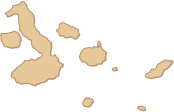Galapagos Islands: Introduction
 |
Report prepared by Meaghan Leslie-Gottschligg and Scott Grimsrud, students in BCIT's Fish, Wildlife and Recreation Program.
Geography
The Galapagos Islands are part of the country of Ecuador and are located in the Pacific Ocean 1,000 km west off the coast of mainland Ecuador. The Galapagos Islands are an archipelago of thirteen major volcanic islands, six smaller islands and 170 rocks and islets scattered on or near the equator. Each major island consists of a single large shield volcano except Isabela (the largest island), which is made up of six volcanoes. Fernandina is the youngest island.
The total land area of the islands is 7,882 square kilometers, so the Galapagos Islands would fit into Canada 1,154 times or into BC 120 times. The lowest elevation is the Pacific Ocean at 0 m and the highest is Wolf Volcano (Isabela Island) at 1,707 m.
The Galapagos Islands are mostly a national park, therefore very little legal natural resource harvesting takes place except for a very small amount of artisanal fishing. Ninety-seven percent of the land in the Galapagos is a national park and three percent is used for urban areas and agriculture.
People
Spanish is spoken by most people living in the Galapagos. Over a 100,000 tourists per year visit the area from all over the world. The tourism industry is highly regulated, allowing only eighty-four ships, carrying 100 people or less, to travel the area's waters each year.
Five of the archipelago's thirteen main islands are inhabited. The year round population ranges from 25,000 to 30,000 people (about 3.8 people/km²). The population growth rate between 1974 and 1997 was about six percent per year: mainland Equadorans were moving to the islands in search of better economic opportunities. Researchers warned that continued immigration was putting stress on the natural resources of the area as well as introducing foreign species that threaten the native flora and fauna.
Introduced by the government of Equador in 1998, the migration law attempts to stop mainlanders from moving to the islands. Unfortunately, the law was not strictly enforced and the population growth rate was still over five percent per year between 1998 and 2001. Apparently, it is not uncommon for Equadorans to obtain false identification cards in order to live on the islands.
Economy
Tourism supports the majority of the population by providing jobs in the support and services sector. Ecotourism is one of the top four foreign exchange earners for Ecuador and ten percent of the population has their family's main earner working directly in conservation. Small quantities of coffee are produced and exported.
 Funded by TEK
Funded by TEK